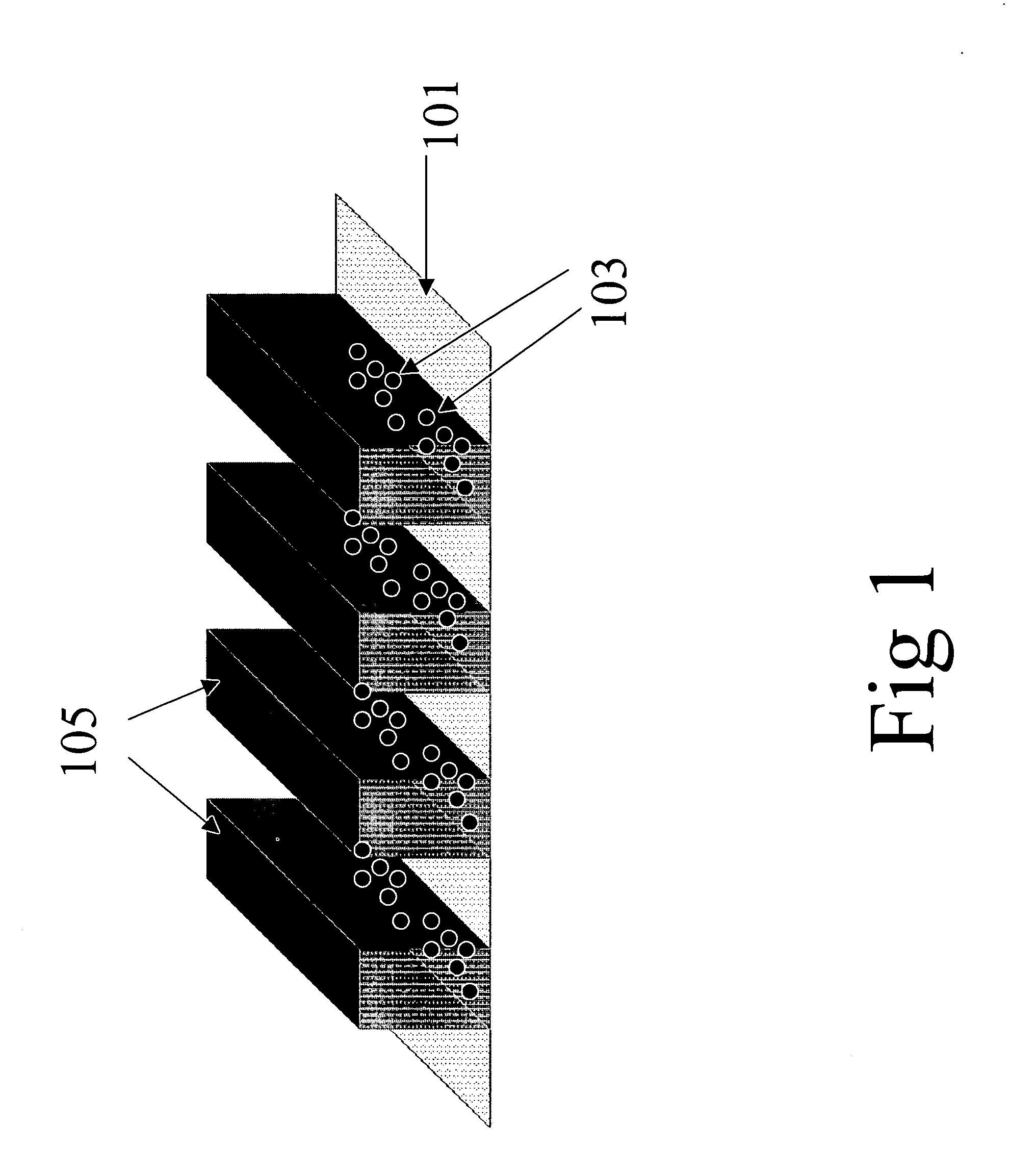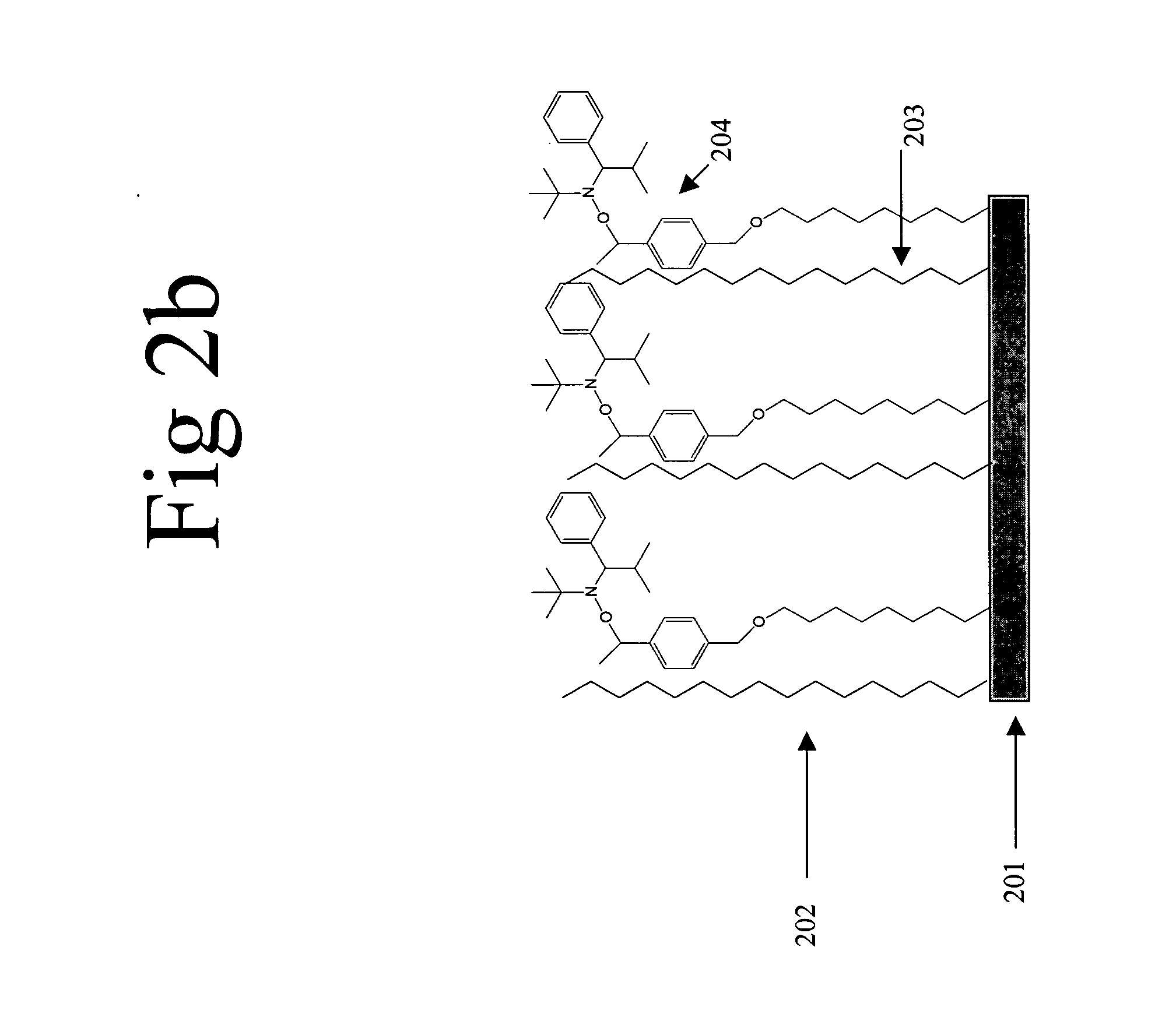Materials and methods for creating imaging layers
- Summary
- Abstract
- Description
- Claims
- Application Information
AI Technical Summary
Benefits of technology
Problems solved by technology
Method used
Image
Examples
example 1
[0056] Substrates with an imaging layer with initiator sites of grafting density G of 0.7 chains / nm2 were prepared as discussed above with respect to FIG. 2. A PMMA photoresist layer was spun on the imaging layer and patterned using EUV-IL. The resulting pattern on each substrate was a 1:150 nm linear pattern (i.e. 50 nm lines, spaced 50 nm apart). Polystyrene patterned brushes were then grown on the substrates. The reaction was stopped at the desired molecular weight and the samples were placed in a Soxhlet extractor and exposed to a toluene solvent for 48 hours. The samples were then removed from the solvent and dried.
[0057] Patterned brushes of various molecular weights were grown and observed. Molecular weight was increased until feature collapse was observed. Feature collapse is the point at which discrete features are no longer observed. FIGS. 9a-c show SEM images of the patterned brushes with various molecular weights. The average molecular weight of the patterned brushes in...
example 2
[0058] Substrates with a 50 m 1:1 linear pattern and a grafting density of 0.25 chains / nm2 were prepared as in Example 1. FIGS. 10a-c show SEM images of the patterned brushes with various molecular weights.
[0059] The average molecular weight of the patterned brushes in FIG. 10a is 17,230 g / mol with PDI equal to 1.25. Feature height is 8 nm. The patterned features are well ordered with few defects. As with the 0.7 chaims / nm2 in Example 1, increasing M results in taller features and more defects. FIG. 10b shows a patterned brush with brushes of 30,290 g / mol and a PDI of 1.40. Height is 13 nm. The patterned features in FIG. 10b have more defects than those in FIG. 10a. The patterned brushes in FIG. 10c have a molecular weight of 37,810 g / mol, a PDI of 1.4 and a height of 16 nm. Defects are observed throughout the pattern. Feature collapse occurred at an M of 44,000 g / mol and a feature height of about 20 nm.
[0060] The results shown in Examples 1 and 2 demonstrate that lower grafting d...
example 3
[0062] Substrates with a 25 nm 1:1 linear pattern and a grafting density of 0.30 chains / nm2 were prepared as described in Example 1. FIGS. 11a and 11b show SEM images of the patterned brushes with various molecular weights. The brushes in FIG. 11b have a M of 17,380 g / mol, a PDI of 1.34 and a height of 10 n-m. Large areas of defects are observed. FIG. 11b shows patterned brushes with M of 24,840, a PDI of 1.33 and a height of 12 nm. As with the pattern shown in FIG. 11a, large areas of defects are observed. Feature collapse occurred at an M of 30,250 g / mol and a height of about 14 nm. Defects due to chains bridging the gaps occurred at all molecular weights. This is due to the fact that gaps of the patterns are 25 nm. Increasing the gap width (i.e. changing the pitch) for a feature size of 25 nm would result in fewer defects.
PUM
| Property | Measurement | Unit |
|---|---|---|
| Size | aaaaa | aaaaa |
| Size | aaaaa | aaaaa |
| Width | aaaaa | aaaaa |
Abstract
Description
Claims
Application Information
 Login to View More
Login to View More - R&D
- Intellectual Property
- Life Sciences
- Materials
- Tech Scout
- Unparalleled Data Quality
- Higher Quality Content
- 60% Fewer Hallucinations
Browse by: Latest US Patents, China's latest patents, Technical Efficacy Thesaurus, Application Domain, Technology Topic, Popular Technical Reports.
© 2025 PatSnap. All rights reserved.Legal|Privacy policy|Modern Slavery Act Transparency Statement|Sitemap|About US| Contact US: help@patsnap.com



